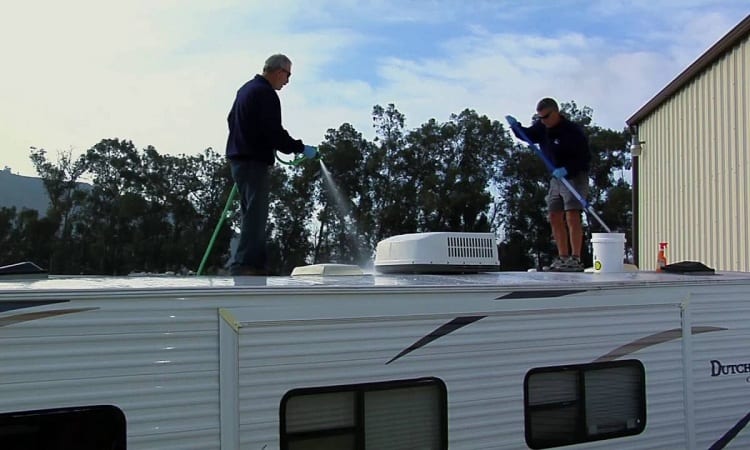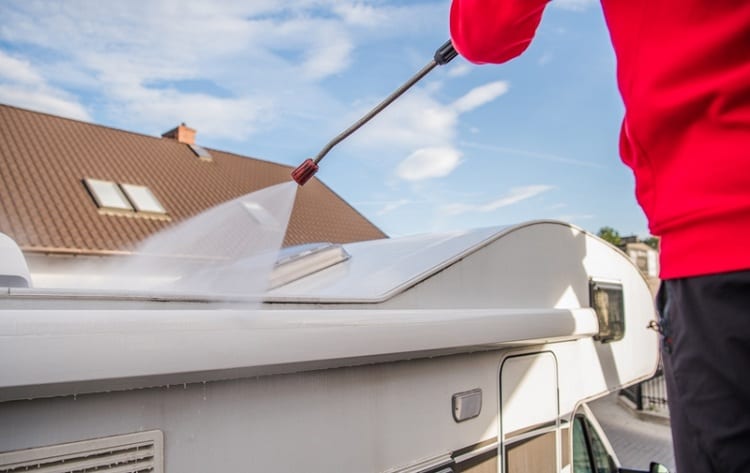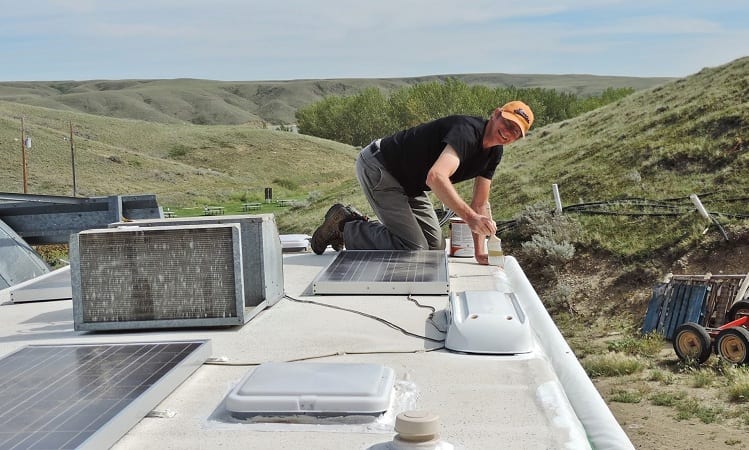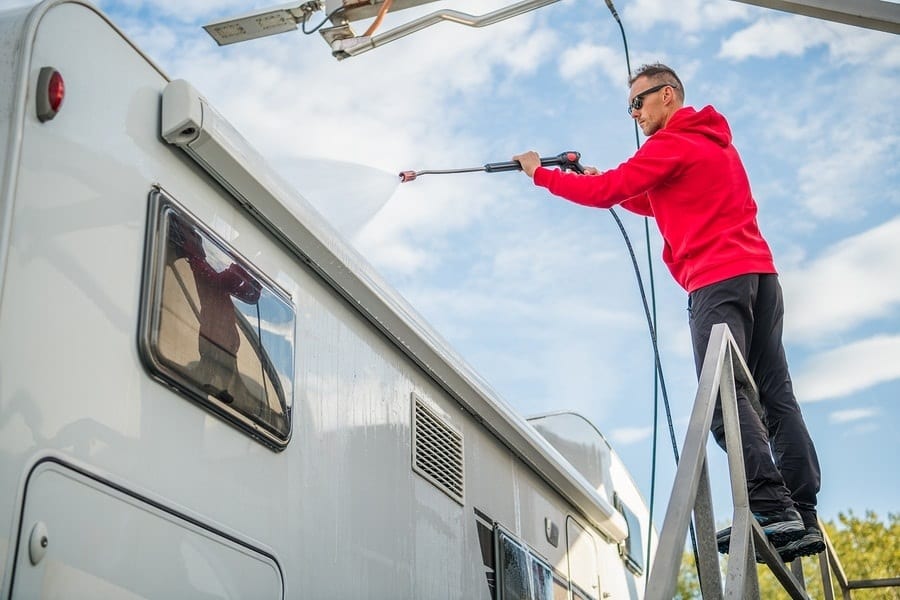Owning an RV means you’re responsible for keeping it in tip-top shape, but one of the most commonly overlooked areas that need our attention is the roof.
An RV’s roof puts up with a lot from the sun, rain, and other external factors, so learning how to keep it clean and in good shape is an essential part of RV ownership.
How do you clean an RV roof properly? Before starting the job, you’ll need to determine the material of your RV’s roof and choose a cleaning product that suits it.
The cleaning solution can then be applied to a freshly rinsed roof and brushed on in sections before being rinsed washed off, with some extra steps taken to protect your RV.
With a little bit of love and some ongoing maintenance, you can keep the roof of your RV in great condition for years to come and save yourself the cost and effort of replacing it prematurely.
Our guide to cleaning RV rooftops will show you everything you need to know about when to do it, how to do it, and which products will be best suited to your camper.
Contents
Why Should You Clean Your RV’s Roof?

The roof of an RV is just as important as the roof of a home, and without it, the insides of your motorhome would go through a whole lot.
Keeping the RV roof clean is the best thing you can do to keep it in good condition which means it continues to protect not only you as the occupant, but the interior of the RV, its electrical wiring, upholstery, walls, floors, and everything else that’s inside.
An RV goes through a whole lot on a standard trip, and the roof is the one thing keeping protected you from blistering hot sun and UV rays, torrential downpours, harsh winds, and other random items that drop from the sky.
One look at the roof can show you just how hard it works for you and your RV, and why cleaning it is important.
Without regular cleaning, the roof of your RV can be prone to oxidization, degradation, and general wear and tear.
During cleaning, you’ll remove anything that’s doing it damage, prevent it from needing to be replaced as often, and find potential areas for repair as you inspect it.
How Often to Do the Job

To determine when you should clean your RV roof, you’ll need to consider how often the vehicle is used.
Those who live in their RV full-time will have roofs in need of more frequent cleaning than a part-time RVer’s roof will, so it all depends on your schedule and the type of conditions you park in.
If you live in your RV or use it frequently, you’ll want to make a point to inspect and clean the roof every couple of months.
For those using it only part-time or for a few trips a year, you should never go more than three months without giving it a clean.
Before you plan on putting your RV in storage, whether it’s for winterization or another season, clean off the roof first.
This will ensure that anything left behind won’t be doing damage while it sits in storage, and allow you to get on top of any repairs or recoats that need to be done in the off-season.
RV Roof Materials and How to Choose the Right Products
Each RV is as unique as its owner and there are lots of different types of roofs out there as well.
The first step to creating a cleaning schedule for your RV roof is to determine what materials it’s made with, as this will show you not only what to clean with, but how to do it correctly.
- Fiberglass: These roofs require less frequent cleaning and stay in generally good condition but their weight makes them a less than enviable option. Cleaning fiberglass requires a specific cleaning agent made for its unique construction.
- Rubber: This is the most common RV roof material and also the easiest to find a cleaning product for, with the two main types of rubber being EPDM and TPO. Determine which rubber yours is made of to ensure you get the right cleaning agent and be prepared to put in some effort.
- Aluminum: These types of roofs are less common these days but are loved for being low maintenance and easy to clean. However, you should only use something safe for aluminum surfaces to avoid damage.
If you’re not able to tell at first glance what the roof is made of, consult the owner’s manual of your RV.
This should give the basics on the roof’s construction and possibly even a list of recommended cleaning agents that suit it, so you don’t have to second guess what you’re using.
The best approach when choosing a roof cleaner is to find one made for this exact purpose and material.
Although there are homemade approaches and DIY cleaning solutions you can make up yourself, you don’t want to risk doing any damage to this expensive and important RV part, so stick to an RV roof cleaning agent to get it right.
The Simple Steps to Cleaning an RV Roof

Now that you’ve established what the roof is made of and have a qualified cleaning product to get the job done, you can assemble the rest of your gear.
You’ll need a ladder, bucket, broom, brush, and hose, so be careful taking this with you to the top of the RV roof to start the cleaning process.
- Start with your broom and sweep any debris away from the top of the roof. Take this time to inspect the roof and make note of any cracks, marks, seals, caulk, or areas that require attention. If needed, do these repairs first before moving onto the cleaning.
- Rinse down the sides of your RV and the roof so that all parts are wet. Keep the vehicle in a shady spot while you clean and try to keep the vehicle wet as well.
- Start at the front of the RV and work in small sections of around 3 x 3 feet, applying the roof cleaner with your brush and brushing in circular motions. Once you finish with one part, rinse it off with clean water before moving on to the next.
- Make your way across the whole RV roof from front to back, working one area at a time and rinsing. When you get to the end, rinse off the entire RV as well as the sides so that no cleaning product is left behind.
- Use a cloth or chamois to dry any excess moisture left behind and allow the RV to dry out of direct sunlight.
An RV Roof in Tip-Top Shape
There’s not a lot you have to do to keep your RV’s roof in good condition, so regular cleaning shouldn’t be hard to manage.
This simple job will keep it in great shape for years to come and help it to fight back against all of the daily wear and tear it goes through so that it never lets you down.
Related Questions
The roof of your RV is what separates you from sun damage, rain, and a whole lot of discomfort, so you want to make sure you’re keeping it in good condition.
There’s plenty more to learn about these camper roofs though, so read on to see how we answered some FAQs that other beginner RVers had about them.
How Long Does RV Roof Last?
The material used to make the roof will impact how long it lasts, but a good quality rubber roof can potentially last up to 20 years on a camper.
This is provided it’s cared for and cleaned regularly, with the likelihood of having to apply another coating at the 10-year mark to keep it in good shape.
How Often Should You Recoat an RV Roof?

A quality rubber roof on an RV should only need to be recoated every 10 years, provided it’s been cared for during this time.
If you notice cracks, degradation, or other signs of wear and tear, you can apply a coat sooner than this, and if the roof is made of less durable material, it might be advisable to do it sooner.
How Do I Protect My RV Roof From Sun?
As well as cleaning it regularly, you can apply dedicated sealants and protectants to an RV roof to provide it with UV protection.
These products are best applied after cleaning the roof and will help to repel UV rays, prevent oxidization, and keep the roof protected from cracks and wear that can occur from sitting out in the sun.
Resources:


